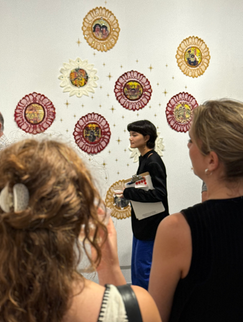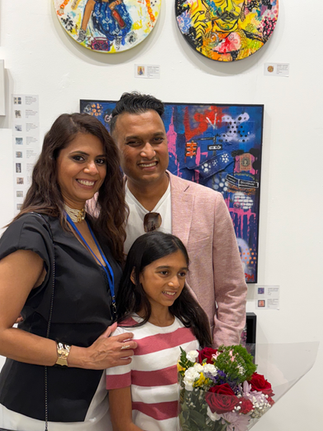Clio Art Fair 21st Edition: A Bold Celebration of Independent Voices
- Art Dealer Street
- Sep 23
- 5 min read
This September, New York’s most independent-minded art fair returned to Chelsea with the highly anticipated 21st edition of Clio Art Fair, held from September 18–21, 2025, at 511 West 25th Street. Known as the “anti-fair” of the art world, Clio continues to stand apart from the mega-fairs by focusing exclusively on independent, self-represented artists.
Following the success of its 20th edition earlier in the month, the 21st edition once again delivered on Clio’s promise: an intimate, democratic, and inspiring platform for discovery. More than 35 international artists filled the Chelsea venue with over 150 works ranging from painting and sculpture to photography, mixed media, and installations. Visitors—collectors, curators, critics, and art lovers alike—were treated to a vibrant weekend of creativity, dialogue, and live performance.
A Fair for the Independents
What makes Clio unique is its unwavering commitment to artists working outside the exclusive gallery system. Instead of navigating the traditional hierarchy of blue-chip fairs, here every artist is given their own space and direct access to collectors. This intimacy fosters genuine conversations and connections. Visitors don’t just view the art—they meet the creators behind it, hear their stories, and understand their processes.
The fair’s atmosphere has often been described by artists as warm, kind, and supportive—a refreshing alternative to the fast-paced, transactional nature of larger events. Many exhibitors highlighted how Clio felt more like a community than a competition, with friendships and collaborations sprouting alongside sales and new professional opportunities.
The Artists of 2025
The 21st edition welcomed a roster of artists from across the globe. From emerging voices to established creators, the diversity was striking. Visitors discovered the ethereal paintings of Bronx-based artist Katherine Miranda, the evocative canvases of South Korean artist Ami Park, the atmospheric works of Daniel Rosenbaum, and the distinctive visions of Deborah L. Morris, MJ King, and Nieves Saah, among many others.
The breadth of perspectives was remarkable. Abstract expressionists hung alongside figurative painters, photographers offered fresh perspectives, and multimedia artists pushed the boundaries of installation. Works ranged in price from as little as $50 to $150,000, making collecting accessible to both first-time buyers and seasoned collectors.
Another Brick in the Wall: The Performance Program
If the visual exhibitions embodied Clio’s ethos of inclusivity, the live performance program gave it a powerful voice. Titled Another Brick in the Wall, the program examined our increasingly digital and fragmented world. Where public squares once served as spaces for collective discourse, we now find ourselves navigating algorithm-driven feeds, curated comment sections, and endless scrolls. The question posed by Clio was urgent: are today’s artists building bridges through these walls or reinforcing them?
The program opened with Gabrielle Meyerowitz’s “Mobile Confessional,” a work that invited audiences into a private yet communal exchange, reimagining intimacy in an era of digital distance. Ama of MetallicFern performed “Do You Hear Me?”—a haunting piece interrogating visibility and voice in the age of constant noise. Tani B. Burwell’s “The Plight of a Magical Girl” wove together performance and storytelling, while Analia Farfan’s “Infidencias” offered a deeply personal meditation on vulnerability and resilience.
Audiences were challenged, moved, and inspired. These performances emphasized Clio’s role not just as a marketplace for art, but as a laboratory of ideas—a space where pressing cultural issues are confronted head-on.
An Intimate Alternative
Clio has always defined itself against the sprawling, often overwhelming scale of major fairs. Instead of endless aisles of booths, Clio integrates artists into the existing architecture of its Chelsea venue, respecting the space and encouraging a more fluid experience. Visitors wander through a curated journey rather than a maze, encountering works at a human scale.

This intimacy is not only physical but emotional. Collectors have remarked on the joy of discovering new talents they might never encounter elsewhere. Artists leave with not just sales, but with an expanded network of peers, supporters, and future collaborators. For many, Clio is not a one-time opportunity but an ongoing community that continues to open doors.
Media and Public Praise
Over the years, Clio has garnered growing attention from the press and art world observers. It has been described as a “breath of fresh air” in the crowded New York art calendar and a place to discover “what’s next” in contemporary art.
Artists themselves often provide the strongest praise. Many describe Clio as one of the most supportive fairs they have ever participated in, citing the attentiveness of staff, the high quality of curation, and the diversity of fellow exhibitors. One artist summed it up beautifully: “Clio made me feel at home. I not only sold work but left with a family of new friends.”
A Fair with Vision
Since its founding, Clio has prided itself on innovation. It was one of the first fairs to accept cryptocurrency payments back in 2017, a bold move that signaled its openness to the evolving ways in which art and commerce intersect.

But Clio’s true vision is not technological—it is cultural. The fair’s founder has consistently emphasized the importance of slowing down, of truly engaging with artworks rather than racing through hundreds of them in minutes. Each work, after all, may have taken months or years to create. At Clio, visitors are encouraged to give art the time and attention it deserves.
Looking Ahead: Clio Art Fair May 2026
As the 21st edition concluded, attention turned to the future. Clio has already announced its next event: the May 2026 editions of the fair, which will continue its tradition of spotlighting self-represented artists.
Applications for May are now open—and in a show of support for the community, Clio is waiving application fees for those who apply early. This is an extraordinary opportunity for independent artists around the world to share their work on one of New York City’s most exciting stages. Collectors, curators, and art lovers can also look forward to another inspiring round of discoveries in the spring.

The 21st edition of Clio Art Fair reaffirmed what has made it such a vital part of New York’s art ecosystem: its independence, inclusivity, and commitment to authentic artistic voices. Over four days in Chelsea, visitors experienced a fair that was as much about connection as it was about commerce, as much about dialogue as display.
As Clio prepares for its 2026 editions, one thing is clear: the fair continues to empower independent artists and invite audiences to experience art in its purest, most personal form. For those seeking the pulse of contemporary art—and the chance to be part of a global community built on creativity and courage—Clio Art Fair is simply unmissable.














































Comments